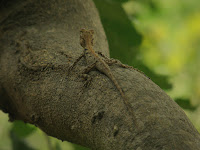



“Transformation” is the word, which inspired me in Adesh Shivkar’s blog last year, in which he depicted the thorough or dramatic change in the form, appearance and characters of Mumbai`s Wildlife region and that is what the OXFORD DICTIONERY defined it too.
Then, I had made up my mind that next year I would also gauge such transformation in hilly forests around Mumbai, including Tungareshwar Wildlife Sanctuary (TWLS), Matheran Hill Forest, Rajmachi , Bhimashankar WLS and my soul Sanjay Gandhi National Park (SGNP). Tungareshwar was on priority having more pristine and closest approachable forest from Mumbai and around. On the World Environment Day, around 15 shutterbugs (mainly from Thane, Mulund and individuals from Dombivli, Vasai, Kandivali & Ulhasnagar) decided to feel such transformation at Tungareshwar. Most of these photographers were interested in macro world, two in butterflies, two in reptiles and four in birding etc. and this newly created WLS served us all that we were interested in, including heavy torrent rains.
Transformation, which changes the colour of forest floor, from brown leaf litter to fresh green grass. Transformation, which changes the mood of birds and reptiles, searching and running behind the mates. Transformation which enforces the spiders, butterflies, grass-hoppers, Mantids and other forest dwelling species to prepare new strategies to search for fresh food. Transformation, which changes the dry river beds to free flow fresh water streams, where several forms of aquatic life survives for these few months. But , this transformation also drives reptiles and amphibians to run behind their mates and sometimes get killed by uncontrolled speeding vehicles, even on the dirt roads of Tungareshwar.
At 8.00 AM we all started from the forest chowki of TWLS and ended up our day till 02.00 PM at Tungareshwar Temple; what followed on this route is listed below.
BIRDS
1) Indian Peafowl (sighting by Bhavik Thaker & Rajnikant Rathod)
2) Brown Capped Pygmy Woodpecker
3) Black Rumped Flameback
4) Brown Headed Barbet
5) Indian Grey Hornbill
6) Small Blue Kingfisher
7) White Throated Kingfisher
8) Green Bee-eater
9) Pied Cuckoo
10) Asian Koel
11) Greater Coucal
12) Plum Headed Parakeet
13) Asian Palm Swifts
14) Black Kite
15) Crested Serpent Eagle
16) Shikra
17) Little Cormorant
18) Cattle Egret
19) Indian Pond Heron
20) Golden Fronted Leafbird
21) Rufous Treepie
22) Large Billed Crow
23) Black Drongo
24) Greater Racket Tailed Drongo
25) Asian Paradise Flycatcher (fully grown male)
26) Common Iora
27) Jungle Myna
28) Red Whiskered Bulbul
29) Common Tailorbir
30) Purple Sunbird
31) Red Vented Bulbul
32) House Sparrow
33) Common Myna
34) House Crow
Butterflies
1) Malabar Spotted Flat
2) Golden Angle
3) Red Spotted Swordtail
4) Lime Butterfly
5) Common Rose
6) Common Grass Yellow
7) Great Orange Tip
8) Psyche
9) Plum Judy
10) Striped Tiger
11) Common Crow
12) Common Bushbrown
13) Baronet
14) Yellow Pansy
15) Chocolate Pansy
16) Blue Pansy
Reptiles
1) Common Bronzeback Tree Snake
2) Forest Calotes
3) Bronze Grass Skink
Monsoon Flora
1) Hill Turmeric
2) Indian Turnsole
The “Transformation” is series of my next few field trips and would be updated accordingly, having next destination at Matheran.
2 comments:
amazing experience
Thanks Bhavik
Post a Comment